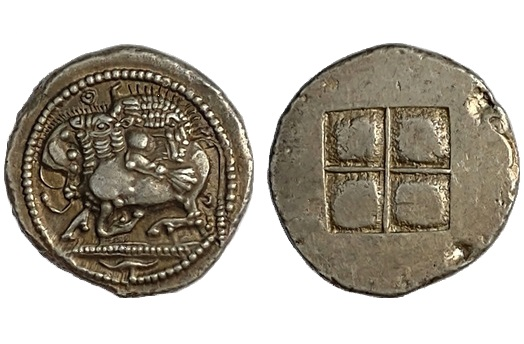
about ancient nomos
Ancient Nomos Art is a museum of galleries exhibiting ancient coins and ancient mint maps. The coin gallery displays the diverse art and history of hand-crafted ancient Greek, Roman, Byzantine, Persian and Medieval coinage. The ancient mints mapping gallery features Greek, Roman, Byzantine, Asia Minor and Medieval mint city regions and territories. Visitor's are welcome to explore, study and enjoy Ancient Nomos Art.

Greek, Akanthos – 525 BC
Akanthos
From Ancient Galleries

Obverse: Lion pouncing to the right, attacking a horned bull crouching left, biting into its hindquarter; symbol Θ above.
Reverse: Quadripartite incuse square with raised fields in the four quadrants.
LEGEND and SYMBOLISM
Obv: Lion pouncing to the right, attacking a horned bull crouching left, biting into its hindquarter; symbol Θ above; floral ornament in exergue below dotted ground line; beaded border. Rev: Quadripartite incuse square.
This coin was struck in the ancient Achaean city of Kaulonia, on the east coast of Bruttium (southern Italy). The ancient theme of the lion-bull combat can be traced back to the figurate art of the third millennium. The earliest known depictions occurs on a ewer found at Uruk dated to the latter part of the Protoliterate period, circa 3300 BC. That ewer has a relief depiction of a lion attacking a bull from behind (see Henri Frankfort, Art and Architecture of the Ancient Orient, 1963). The scene became widely distributed by 500 BC, featuring prominently in the Achaemenid Empire, and in particular at the palace of Darios in Persepolis, where it occurs no fewer than twenty seven times, including on the main staircase leading to the imperial complex. Its frequent appearance in key locations strongly suggests an important symbolic significance, which unfortunately has not survived antiquity in any explicitly clear form. The lion and bull design is common to the tetradrachms of Akanthos from the sixth to the early fourth century BC. The earliest tetradrachms are characterized by thick, dumpy flans, a variable style of incuse, and the head of the lion in three-quarter perspective. Subsequent issues, however, have a flan that is relatively thinner and broader, an incuse of a more regularly quadripartite style, and the head of the lion in profile. The floral symbol in the exergue, which first appeared on some of the earliest tetradrachms, became more stylized in subsequent issues, and sometimes was replaced with other symbols, such as a fish. Later, a pellet-in-annulet appeared above the lion on the obverse, followed by the addition of a subsidiary letter, and, finally, letter combinations and symbols. The series was initially struck on the Attic standard, but when the city became an ally of the Persians in 480 BC, they adopted the Phoenician standard that was common among Persian coinages of the time. Explanations for the symbolism and its power over the ancient peoples who reproduced it with prodigious enthusiasm have ranged from it being an expression of royal power, to its being an astronomical allusion, as well it being an embodiment of the constant struggle between civilization (represented by the domesticated bull), and nature (represented by the untamable lion). This latter argument may well hold true for the Mesopotamians of Uruk, who it is known took a rather grim view of the world, seeing it as a battleground of opposing powers.
DOCUMENTATION
Value: Tetradrachm. Metal: AR Silver. Weight: 17.16 grams. Mint: Akanthos, Macedon. Date: 525-470 BC.
Attribution: Desneux 48–68 var. (unlisted dies); AMNG III/2, 5; HGC 3, 383, CNG 123, 56 (this coin).
Legend, Documentation and Attribution
